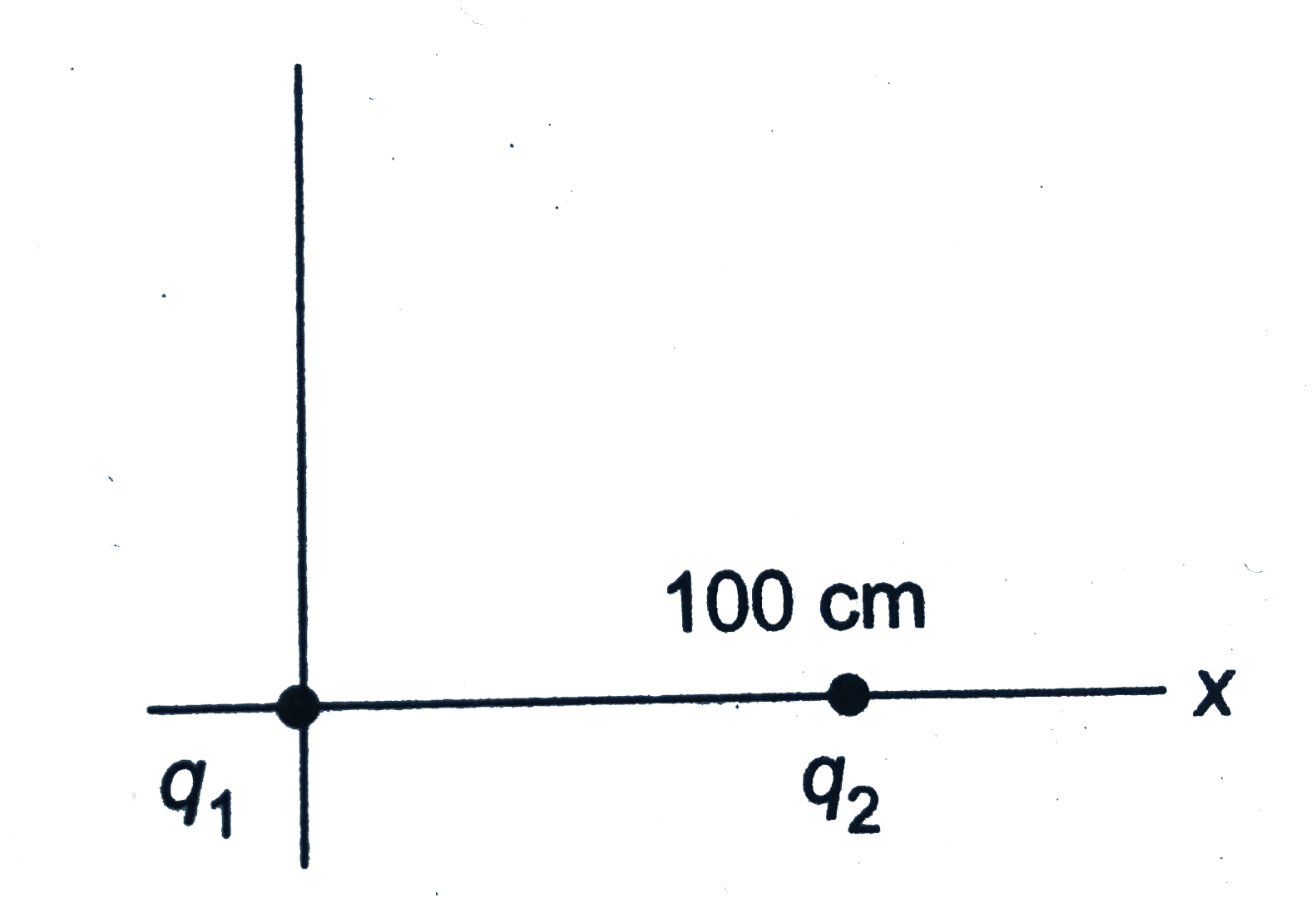A point charge q1=9.1μC is held fixe at origin. A second pont charge q2=−0.42μC and a mass 3.2×10−4kg is placed on the x-axis, 0.96m from the origin. The second point charge is released at rest. What is its speed when it is 0.24m from the origin?
To solve the problem, we will use the principle of conservation of mechanical energy. The total mechanical energy of the system remains constant when the second charge is released.
1. Identify the Initial and Final Positions:
- The initial position of charge q2 is ri=0.96m.
- The final position of charge q2 is rf=0.24m.
2. Calculate the Initial Potential Energy:
- The potential energy Ui when q2 is at ri is given by:
Ui=kq1q2ri
- Where k is Coulomb's constant, k=8.99×109N m2/C2.
- Substitute q1=9.1μC=9.1×10−6C and q2=−0.42μC=−0.42×10−6C.
3. Calculate the Final Potential Energy:
- The potential energy Uf when q2 is at rf is given by:
Uf=kq1q2rf
4. Apply Conservation of Mechanical Energy:
- The total mechanical energy at the initial position (all potential energy, as it starts from rest) equals the total mechanical energy at the final position (potential energy + kinetic energy):
Ui=Uf+Kf
- Where Kf is the final kinetic energy given by:
Kf=12mv2
5. Rearranging the Equation:
- Rearranging gives:
12mv2=Ui−Uf
- Therefore, we can express v2 as:
v2=2m(Ui−Uf)
6. Substituting Values:
- Calculate Ui and Uf:
Ui=k(9.1×10−6)(−0.42×10−6)0.96
Uf=k(9.1×10−6)(−0.42×10−6)0.24
- Substitute these into the equation for v2.
7. Calculate the Speed:
- Finally, take the square root to find v:
v=√2m(Ui−Uf)
Final Calculation:
1. Calculate Ui and Uf using the values for k, q1, and q2.
2. Substitute m=3.2×10−4kg into the equation for v.
3. Evaluate to find the speed v.
- The initial position of charge q2 is ri=0.96m.
- The final position of charge q2 is rf=0.24m.
- The potential energy Ui when q2 is at ri is given by:
Ui=kq1q2ri
- Where k is Coulomb's constant, k=8.99×109N m2/C2.
- Substitute q1=9.1μC=9.1×10−6C and q2=−0.42μC=−0.42×10−6C.
- The potential energy Uf when q2 is at rf is given by:
Uf=kq1q2rf
- The total mechanical energy at the initial position (all potential energy, as it starts from rest) equals the total mechanical energy at the final position (potential energy + kinetic energy):
Ui=Uf+Kf
- Where Kf is the final kinetic energy given by:
Kf=12mv2
- Rearranging gives:
12mv2=Ui−Uf
- Therefore, we can express v2 as:
v2=2m(Ui−Uf)
- Calculate Ui and Uf:
Ui=k(9.1×10−6)(−0.42×10−6)0.96
Uf=k(9.1×10−6)(−0.42×10−6)0.24
- Substitute these into the equation for v2.
- Finally, take the square root to find v:
v=√2m(Ui−Uf)
1. Calculate Ui and Uf using the values for k, q1, and q2.
2. Substitute m=3.2×10−4kg into the equation for v.
3. Evaluate to find the speed v.
Topper's Solved these Questions
- ELECTROSTATIC POTENTIAL AND CAPACITORSBOOK - DC PANDEY ENGLISHCHAPTER - ELECTROSTATIC POTENTIAL AND CAPACITORSEXERCISE - Check point 2.1
15 Videos
- ELECTROSTATIC POTENTIAL AND CAPACITORSBOOK - DC PANDEY ENGLISHCHAPTER - ELECTROSTATIC POTENTIAL AND CAPACITORSEXERCISE - Check point 2.2
15 Videos
- ELECTROMAGNETIC WAVESBOOK - DC PANDEY ENGLISHCHAPTER - ELECTROMAGNETIC WAVESEXERCISE - Sec C
22 Videos
- ELECTROSTATICSBOOK - DC PANDEY ENGLISHCHAPTER - ELECTROSTATICSEXERCISE - Medical entrances gallery
37 Videos
Similar Questions
A point charge q1=9.1μC is held fixed at origin. A second point charge q2=−0.42μC and a mass 3.2×10−4kg is placed on the x-axis, 0.96m from the origin. The second point charge is released at rest. What is its speed when it is 0.24m from the origin?
View SolutionA point charge q1=1.0μC is held fixed at origin. A second point charge q2=−2.0μC and a mass 10−4 kg is placed on the x-axis, 1.0 m from the origin. The second point charge is released from rest. What is its speed when it is 0.5 m from the origin?
View SolutionA point charge q1=+2μC is placed at the origin of coordinates. A second charge, q2=−3μC, is placed on the x-axis at x=100cm. At what point (or points) on the x-axis will the absolute potential be zero?

View SolutionA point charge q1=−5.8μC is held stationary at the origin. A second point charge q2=+4.3μC moves from the pont (0.26m0,0) to (0.38m,0,0). How much work is done by the electric force on q2?
View SolutionA point charge q1=−5.8μC is held stationary at the origin. A second point charge q2=+4.3μC moves from the point (0.26m0,0) to (0.38m,0,0). How much work is done by the electric force on q2?
View SolutionA point charge q1=+2.40μC is held stationary at the origin. A second point charge q2=−4.30μC moves from the point x=0.150 m, y=0 to the point x=0.250 m, y=0.250 m. How much work is done by the electric force on q2?
View SolutionA point charge q1=4.00nC is placed at the origin, and a second point charge q2=−3.00nC, placed on the x-axis at x = + 20.0 cm. A third point charge q3=2.00nC is placed on the X-axis between q1,andq2. (Take as zero the potential energy of the three charges when they are infinitely far apart).
(a) What is the potential energy of the system of the three charges if q3 is placed at x= + 10.0 cm?
(b) Where should q3 be placed to make the potential energy of the system equal to zero?
View SolutionA point charge q1=−1.0μC is held stationary at the origin. A second point charge q2=+2.0μC moves from the point (1.0m,0,0) to (2.0m,0,0). How much work is done by the electric force on q2?
View SolutionA charge q=−2.0μC is placed at origin. Find the electric field at (3m,4m,0).
View SolutionA point charge q1 is held stationary at the origin. A second charge q2 is placed at a point a, and the electric potential energy of the pair of charges is −6.4×10−8J. When the second charge is moved to point b, the electric force on the charge does 4.2×10−8J of work. What is the electric potential energy of the pair of charges when the second charge is at point b?
View Solution
